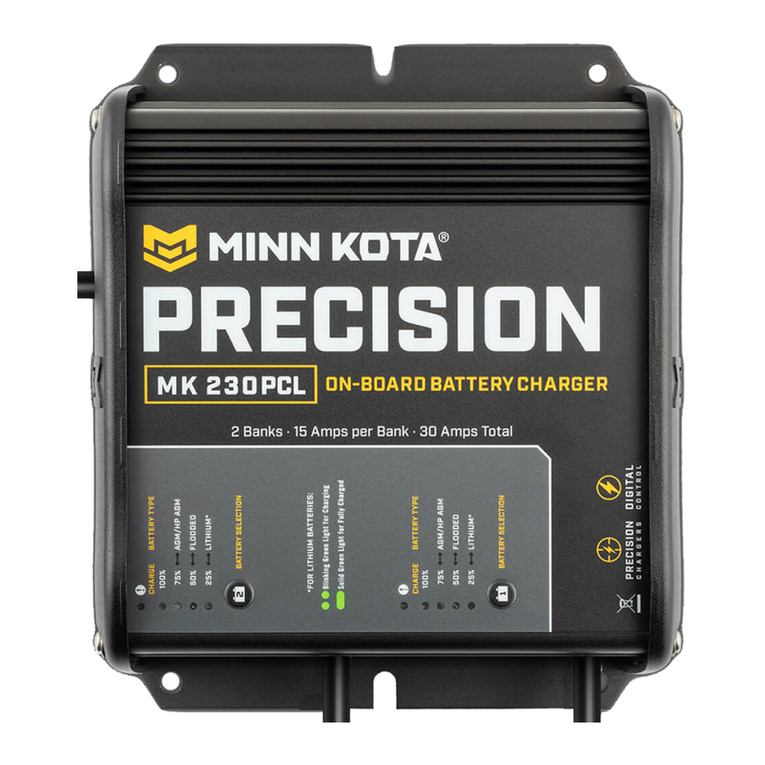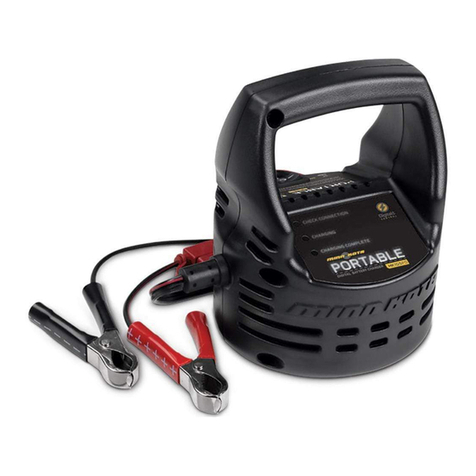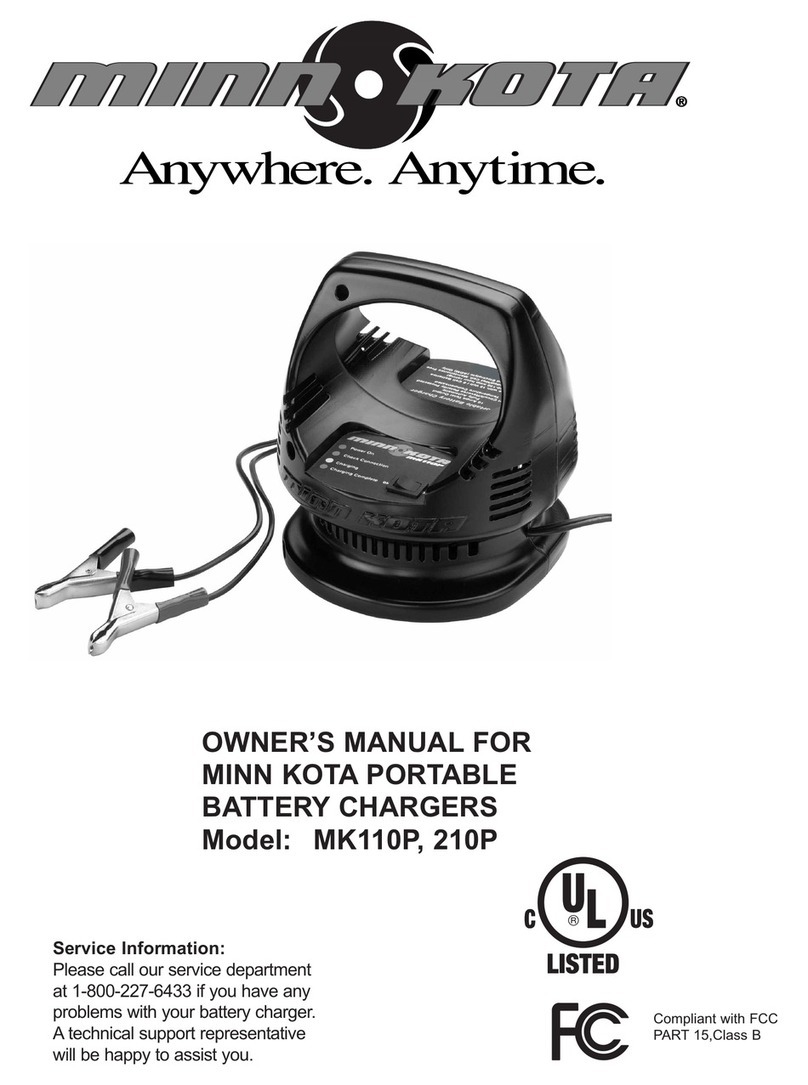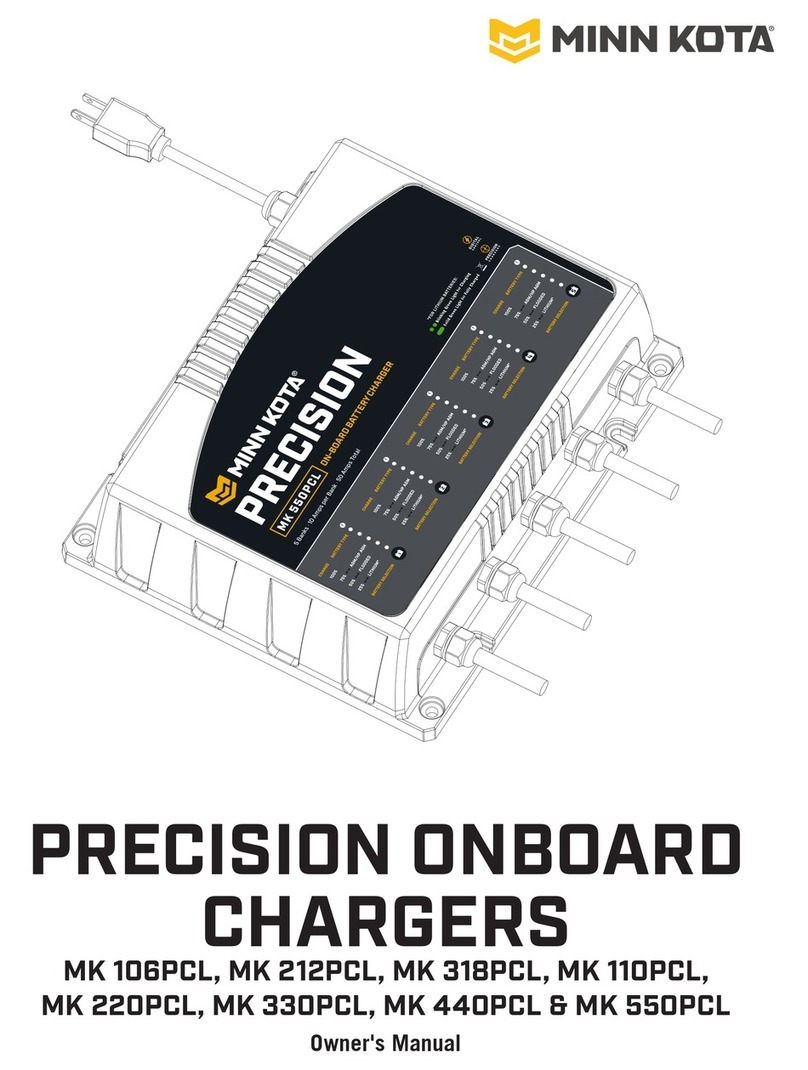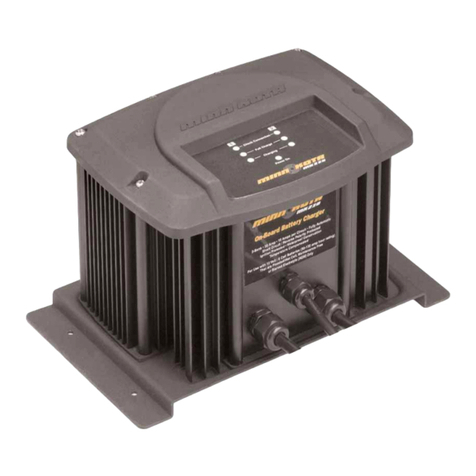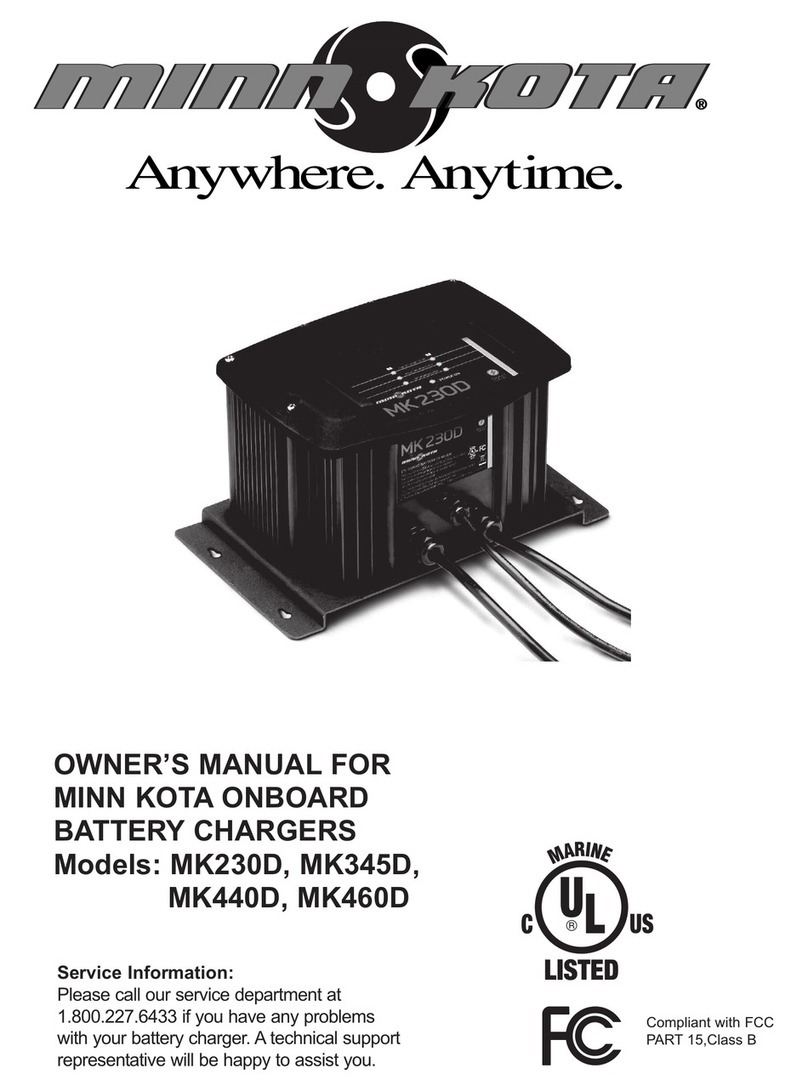MINN KOTA MK115PC User manual

OWNER’S MANUAL FOR
MINN KOTA ONBOARD
BATTERY CHARGERS
Models: MK115PC, MK230PC,
MK345PC, MK460PC
Service Information:
Please call our service department at
1.800.227.6433 if you have any problems
with your battery charger. A technical support
representative will be happy to assist you.
Compliant with FCC
PART 15, Class A
Designed and Constructed to
Marine UL1236 Standard.

2
1) IMPORTANT SAFETY INSTRUCTIONS
a) SAVE THESE INSTRUCTIONS! This manual contains important safety and operating instructions applicable to the safe and efficient use
of your Minn Kota battery charger.
b) The Minn Kota battery charger is a powerful electrical device. If incorrectly installed, configured or operated, the battery charger can damage
batteries and / or electrical equipment. Please thoroughly read the instructions and safety information contained in this manual before operat-
ing the battery charger.
c) Use of an attachment not recommended or sold by Johnson Outdoors Inc. may result in risk of fire, electric shock, or injury to persons or prop-
erty.
d) The charger is not intended for use by young children or infirm persons without supervision. Young children should be supervised to ensure that they do not
play with the charger.
e) To reduce risk of damage to electric plug or cord, pull by the plug rather than the cord when disconnecting the battery charger.
f) An extension cord should not be used unless absolutely necessary. Use of the improper extension cord could result in a risk of fire or electric
shock. If extension cord must be used, make sure:
i) That pins of plug of the extension cord are the same number, size and shape of those of the plug on the battery charger;
ii) That extension cord is properly wired and in good electrical condition; and
iii) That wire in extension cord is proper size as follows:
g) Do not operate the battery charger with a damaged cord or plug.
h) Do not operate the battery charger if it has received a sharp blow, been dropped or otherwise damaged in any way.
i) Do not disassemble the charger. Incorrect reassembly may result in a risk of electric shock or fire.
j) To reduce risk of electric shock, unplug the charger from outlet before attempting any maintenance or cleaning. Disconnecting the leads will not
reduce this risk.
k) To reduce risk of shock or spark, never touch the ring terminals together while the charger is plugged into an outlet or extension cord.
l) External connections to the battery charger shall comply with the United States Coast Guard electrical regulations (33CFR183, Sub Part 1).
2) PERSONAL PRECAUTIONS
a) Consider having someone close enough nearby to come to your aid when you work near a lead acid battery.
b) Have plenty of fresh water and soap nearby in case battery acid contacts skin, clothing or eyes.
WARNING: RISK OF EXPLOSIVE GASES
WORKING IN THE VICINITY OF A LEAD ACID BATTERY IS DANGEROUS. BATTERIES CONTAIN SULFURIC ACID AND PRODUCE
EXPLOSIVE GASES. A BATTERY EXPLOSION COULD RESULT IN LOSS OF EYESIGHT OR SERIOUS BURNS. FOR THIS REASON, IT
IS OF UTMOST IMPORTANCE THAT YOU FOLLOW THE INSTRUCTIONS EACH TIME YOU USE THE CHARGER.
TO REDUCE THE RISK OF BATTERY EXPLOSION, FOLLOW THESE INSTRUCTIONS AND THOSE PUBLISHED BY THE BATTERY
MANUFACTURER FOR ANY EQUIPMENT YOU INTEND TO USE IN THE VICINITY OF THE BATTERY. REVIEW CAUTIONARY
MARKINGS ON THESE PRODUCTS AND ON ENGINE, MOTOR OR OTHER EQUIPMENT REQUIRING BATTERY USAGE.
Minimum recommended AWG wire size for various length extension cords used with the Minn Kota battery charger:
MK115PC Length of Cord in feet 25 50 100 MK230PC Length of Cord in feet 25 50 100
AWG Size 18 18 16 AWG Size 16 16 12
MK345PC Length of Cord in feet 25 50 100 MK460PC Length of Cord in feet 25 50 100
AWG Size 16 12 10 AWG Size 14 12 10
WARNING – DO NOT ATTEMPT TO REPAIR OR SERVICE THE CHARGER YOURSELF. OPENING THE CHARGER MAY EXPOSE YOU
TO HIGH VOLTAGES, THE RISK OF ELECTRIC SHOCK, AND OTHER HAZARDS.

c) Wear complete eye protection and clothing protection. Avoid touching eyes while working near battery.
d) If battery acid contacts skin or clothing, wash immediately with soap and water. If acid enters eye, immediately flush eye with running cold
water for at least 10 minutes and get medical attention immediately.
e) Never smoke or allow a spark or flame in vicinity of battery, engine, motor or other flammable or explosive equipment.
f) Be extra cautious to reduce risk of dropping a metal tool onto the battery or across the battery terminals. It might spark or short circuit the bat-
tery or other electrical component that may cause an explosion.
g) Remove personal metal items such as rings, bracelets, necklaces, and watches when working with a lead acid battery. A lead acid battery
can produce a short circuit current high enough to weld such items, causing severe burns.
h) Use the Minn Kota battery charger for charging and maintaining FLOODED LEAD-ACID, MAINTENANCE FREE, GEL CELL, AND AGM /
STARVED ELECTROLYTE batteries only. It is not intended to supply power to low voltage electrical systems other than for charging and
maintaining batteries. Do not use the charger for charging dry-cell batteries that are commonly used with home appliances. These batteries
may burst and cause injury to persons and damage to property.
i) NEVER charge a frozen battery.
3) PREPARING TO CHARGE
a) If necessary to remove battery from boat or vehicle to charge or maintain, always remove grounded terminal from battery first (if applicable).
Make sure all accessories in the boat or vehicle are off, so as not to cause an arc.
b) Be sure area around battery is well ventilated while battery is being charged or maintained.
c) Clean battery terminals. Be careful to keep corrosion from coming in contact with eyes.
d) Add distilled water in each cell until battery acid reaches level specified by battery manufacturer. Do not overfill. For a battery without remov-
able cell caps, such as valve regulated lead acid batteries, carefully follow manufacturer’s recharging instructions.
e) Study all battery manufacturers’ specific precautions while charging and for recommended rates of charge.
4) CHARGER LOCATION AND MOUNTING
a) Locate charger as far away from battery as the dc cables permit.
b) Never place charger above battery being charged; gases from battery will corrode and damage charger.
c) Never allow battery acid to drip on charger when reading electrolyte specific gravity or filling battery.
d) Do not operate charger in a closed-in area or restrict ventilation in any way.
e) Do not set a battery on top of charger.
f) Do not mount the charger below the waterline of the boat or directly adjacent to fuel tanks.
g) Each DC output cord is six feet long. Make sure that all DC output cords can reach the batteries and that the AC power cord can reach a
power source. When using an extension cord, make the AC connection to the charger outside of the battery compartment as far away as
practical to reduce the risk of a spark igniting gasses in the compartment.
h) Each output cord is equipped with a temperature sensor. By monitoring external temperature, the battery charger adjusts the charging profile
of the battery to assure full charge without overcharging or undercharging the battery. Attempting to shorten the output wires could damage
the temperature sensor and affect the charger output.
i) If the DC battery leads are not long enough, they may be lengthened by splicing and soldering 12 AWG (minimum) wire. Each splice should
be covered with dual wall adhesive lined heat shrink tubing to protect the joint from corroding. The splice should be made between the
fork in the output cable and the fuse holder. The fuse holder should always remain within 7” of the battery terminals. The maximum exten-
sion length is 15 feet. You may contact the Minn Kota Service Department with any questions. Do not splice the AC power cord, as this
voids the three year Limited Warranty.
3

j) Even though the Minn Kota charger is capable of operating in a high ambient temperature environment, a minimum of six inches of unobstruct-
ed area should be allowed on all sides of the unit for proper air circulation and cooling. Proper cooling and circulation will allow the charger to
operate at peak efficiency.
k) MOUNTING THE CHARGER:
Due to the weight of the charger and the impact that boats routinely endure, take the time to securely mount the charger to prevent damage.
Mounting with nuts, bolts and washers is preferable to mounting with screws. Use the largest diameter bolts possible and use all four mount-
ing holes. After marking the locations, set the charger aside and drill the holes. Apply a marine grade silicone sealant in each of the drilled
holes to create a waterproof seal. Then secure the charger in place using the mounting hardware.
l) Your battery charger is supplied with an AC plug holder designed to hold the power cord plug when not in use. Mount the AC plug holder with
four screws in a convenient dry site to prevent corrosion to the AC plug and to prevent the AC plug from making contact with the battery
posts.
5) DC CONNECTION PRECAUTIONS
a) The Minn Kota charger will only charge 12 volt 6 cell lead acid batteries. Do not connect the output of the charger to any other voltage or
type of battery.
b) The charger’s DC output terminals are designed to be permanently mounted and connected to batteries.
c) Connect and disconnect DC output terminals only after disconnecting the AC plug from the electric outlet.
d) The charger output leads must be connected with the correct polarity for the charger to function. The RED lead must be connected to the
POSITIVE terminal of the battery and the BLACK lead must be connected to the NEGATIVE terminal of the battery, as indicated in e(5), e(6)
and f(2), f(3).
e) FOLLOW THESE STEPS WHEN THE BATTERY CHARGER IS INSTALLED IN A BOAT OR VEHICLE. A SPARK NEAR THE BATTERY
MAY CAUSE BATTERY EXPLOSION. TO REDUCE THE RISK OF A SPARK NEAR THE BATTERY:
1) Position AC and DC cords to reduce risk of damage by hood, door, or moving engine parts.
2) Stay clear of fan blades, belts, pulleys and other parts that can cause injury to persons.
3) Check polarity of battery posts. POSITIVE (POS, P, +) battery post is usually larger in diameter than NEGATIVE (NEG, N, -) post.
4) Determine which post of the battery is grounded (connected) to the chassis (if any). If negative post is grounded to the boat hull or chassis
(as in most vehicles), see (5) below. If positive post is grounded to the boat hull or chassis, see (6) below. If neither is grounded, the
order in which the output leads are connected does not matter.
5) For negative-grounded boat or vehicle, connect POSITIVE (RED) output terminal to POSITIVE (POS, P, +) ungrounded post of battery
first. Then connect NEGATIVE (BLACK) output to NEGATIVE (NEG, N, -) grounded post of battery.
6) For positive-grounded boat or vehicle, connect NEGATIVE (BLACK) output to NEGATIVE (NEG, N, -) ungrounded post of battery first.
Then, connect POSITIVE (RED) output terminal to POSITIVE (POS, P, +) grounded post of battery.
7) When disconnecting charger, disconnect AC power cord from electric outlet first.
8) See operating instructions for length of charge information.
f) FOLLOW THESE STEPS WHEN BATTERY IS OUTSIDE BOAT OR VEHICLE. A SPARK NEAR BATTERY MAY CAUSE BATTERY
EXPLOSION. TO REDUCE THE RISK OF A SPARK NEAR BATTERY:
1) Check polarity of battery posts. POSITIVE (POS, P, +) battery post is usually larger in diameter than NEGATIVE (NEG, N, -) post.
2) Connect POSITIVE (RED) output terminal to POSITIVE (POS, P, +) post of battery.
3) Connect NEGATIVE (BLACK) output terminal to NEGATIVE (NEG, N, -) post of battery.
WARNING – MAKE SURE THE CHARGER IS DISCONNECTED FROM AC POWER BEFORE CONNECTING THE BATTERIES TO THE
OUTPUT CORDS.
CAUTION - Before making any connections to batteries in a confined space (such as a battery compartment of a boat), open the door or hatch
of the compartment and allow it to air out for 15 minutes. This allows any gasses that have accumulated in the compartment to escape.
4
CAUTION – Because the body of the battery charger is metallic, do not directly mount the charger to the hull of an aluminum boat. Use a
means of isolation (such as wood or plastic) to prevent the charger body as well as mounting fasteners from coming in contact with the alumi-
num boat structure or hull. Doing so will eliminate any risk of electrolysis that may occur when AC power is connected to the charger.

4) Do not face battery when making final connection.
5) When disconnecting charger, disconnect AC power cord from electric outlet first.
6) When disconnecting output terminals from battery posts, always do so in reverse sequence of the connecting procedure.
7) A marine (boat) battery does not need to be removed and charged on shore. However, instructions must be followed for location of
charger when permanently mounted or used on board.
6) GROUNDING AND AC POWER CORD CONNECTION INSTRUCTIONS
The Minn Kota battery charger should be grounded to reduce risk of electric shock. The charger is equipped with an electric AC power cord
with a grounded plug. The plug must be plugged into an outlet that is properly installed and grounded in accordance with all local codes and
ordinances.
7) OPERATING INSTRUCTIONS
This is a high performance battery charger that has the ability to properly and safely work with several different battery types. It is important to
read and understand how to properly use the battery charger before charging batteries.
Each output bank is independent and isolated from one another and the AC input. The Minn Kota charger can charge independent batteries or
combinations of batteries hooked in series or parallel without disconnecting the batteries from any switches or wires / straps joining the batteries.
See diagram on page 10.
INDICATOR LEDs:
Each bank has the following LEDs:
- Power On (GREEN). This LED is on anytime power is applied to the unit.
- (RED): A steady RED LED indicates there is an issue with a connection. A flashing RED LED indicates an error. See Error
Conditions.
- 25%, 50%, 75% (YELLOW): These LEDs indicate the progress of charging.
- 100% (GREEN): Flashing GREEN LED indicates battery is fully charged in Maintenance Mode and ready to use. Steady GREEN LED indi-
cates battery is fully charged in long term Maintenance Mode and ready to use.
MULTI-STAGE CHARGING:
Minn Kota’s Multi-Stage Charging delivers a fast, precise charge profile by automatically controlling current and voltage without overcharging
your batteries.
Bulk Mode
During this stage, the charger delivers full current until the battery reaches ~75% charge.
Absorption Mode
The charging current tapers down while the battery voltage is held constant (see Table 1 for voltages).
Mild Equalize Mode (Flooded Lead-Acid Only)
The voltage is automatically increased with each charging cycle for a maximum of 1.5 hours to desulfate and mix fluids in each battery.
Equalize Mode (Flooded Lead-Acid Only)
The equalize mode must be manually selected for each bank that is to be equalized. The voltage is increased for a maximum of 4
hours to desulfate and mix fluids in each battery.
Maintenance Mode
When the battery reaches full charge, the charger voltage is reduced (see Table 1 for voltages). A flashing 100% GREEN LED is lit for each
bank to indicate the battery is in Maintenance Mode and ready to use. After 24 hours, the charger automatically turns off and a steady 100%
GREEN LED is lit for each bak to indicate the battery is in long term Maintenance Mode and ready to use. The charger will automatically turn
on when the battery voltage drops below 12.6V.
CAUTION - Due to the high charging current of the Minn Kota charger, it is recommended that each output be connected to only one battery.
Connecting 2 output banks to one battery may cause excessive heating in the battery and could cause acid leakage or battery explosion.
5
CAUTION – To reduce risk of fire or electric shock, connect battery charger directly to grounding receptacle (three-prong). An adapter should
not be used with battery charger.
DANGER – Never alter AC cord or plug provided – if it will not fit outlet, have proper outlet installed by a qualified electrician. Improper con-
nection can result in a risk of an electric shock.
This manual suits for next models
10
Table of contents
Other MINN KOTA Batteries Charger manuals
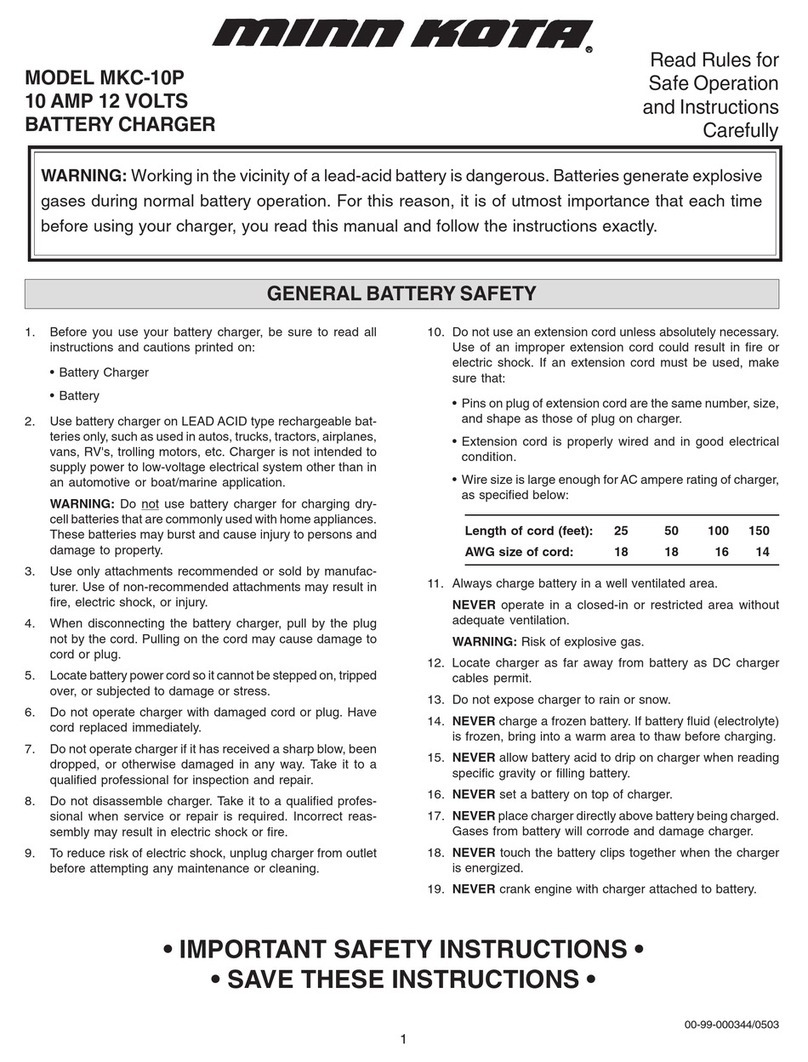
MINN KOTA
MINN KOTA MKC-10P User manual
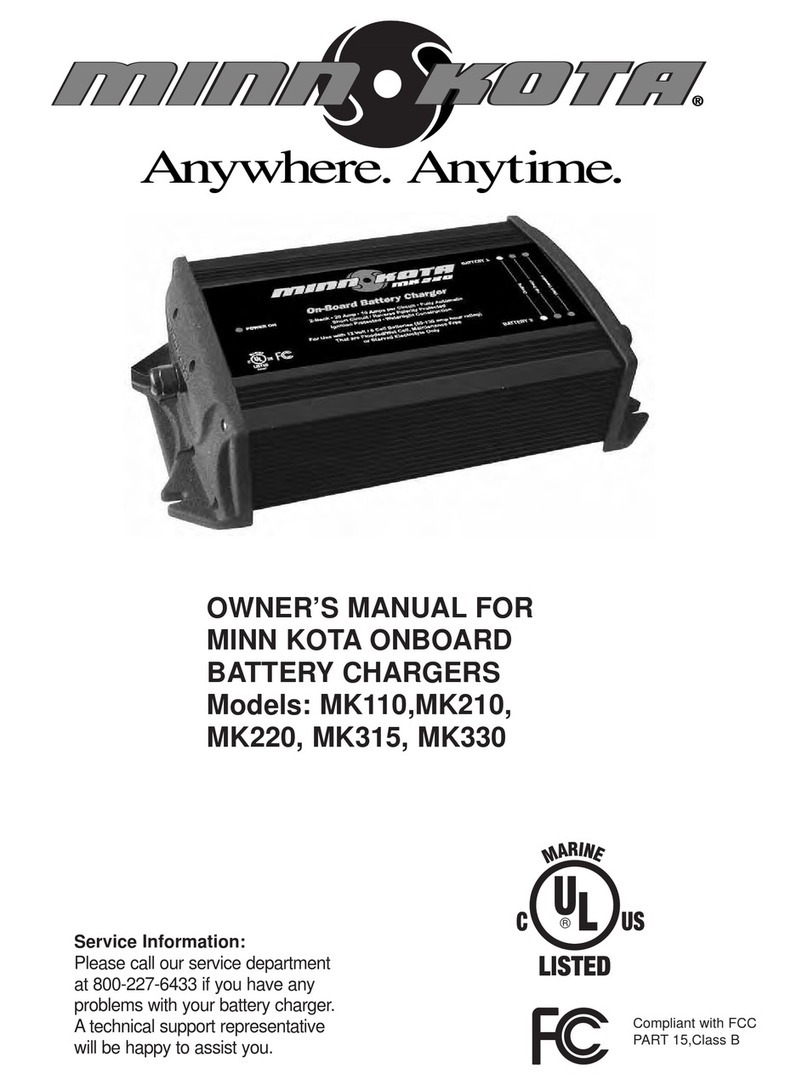
MINN KOTA
MINN KOTA MK110 User manual

MINN KOTA
MINN KOTA MK106PC User manual
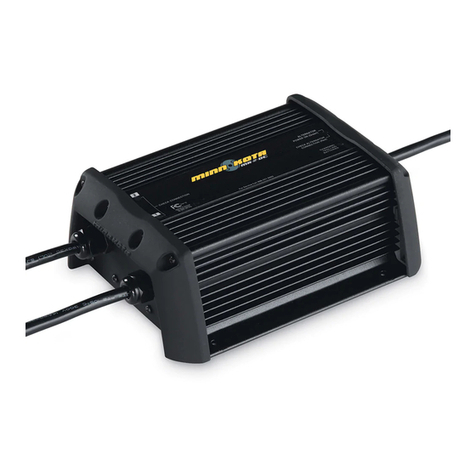
MINN KOTA
MINN KOTA MK-1-DC User manual

MINN KOTA
MINN KOTA 1821065 User manual

MINN KOTA
MINN KOTA MKC-10 User manual
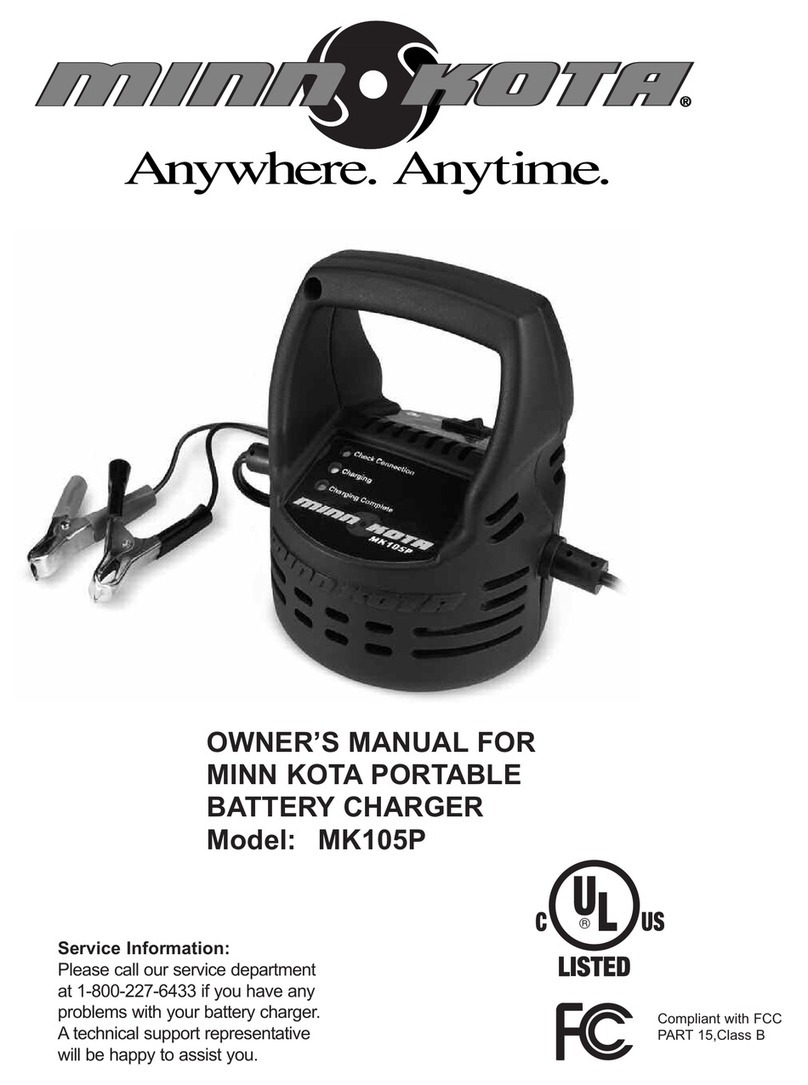
MINN KOTA
MINN KOTA MK105P User manual
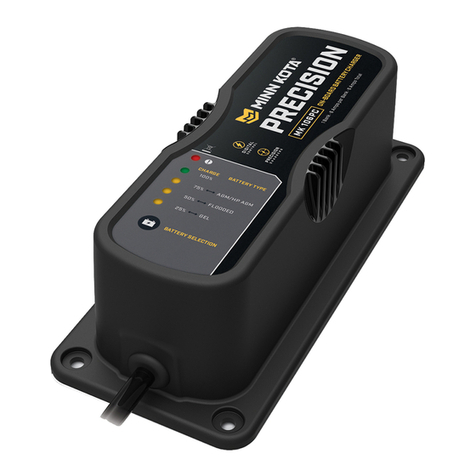
MINN KOTA
MINN KOTA MK106PC User manual
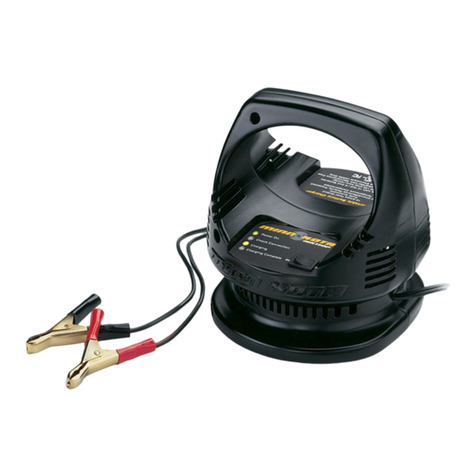
MINN KOTA
MINN KOTA 210P User manual

MINN KOTA
MINN KOTA MK105P User manual
